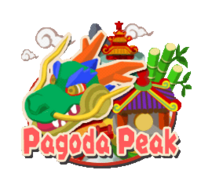Pagoda Peak
Template:Board-infobox Pagoda Peak is a board from Mario Party 7 that resembles an ancient Chinese mountain (said to be 4,000 years old) mixed with Japanese buildings. Here, Kung Fu Koopas are in charge of the Orb Huts. An old Koopa, named Koopa Master, lives at the top of the mountain. He will give a character who reaches the peak of the mountain a Star for the number of coins shown above his house (10, 20, 30 or 40). Each time someone trades coins for a Star from him, the price of each additional Star will go up by 10 coins (to a maximum of 40 coins). After 40 coins, it resets back to 10 coins. In Solo Cruise, the winning condition is to collect 100 coins and reach the top first to trade them with Koopa Master for a Master Koopa T-Shirt.
Events
- Landing on the Green Space near the start lets Toadsworth ask if the player wants to use one of his bottle rockets. Accepting lets the player choose which one to ride on. Then, when they are tied up onto it, the chosen rocket takes them to a higher part of the board, or back to the start of the board.
- Landing on a Green Space next to one of the Gongs of Fate makes Koopa Master appear and lets the player bash the gong to change the price of the current Star. He then gives them coins.
- The Green Space next to Kung Fu Falls makes Koopa Master appear to let the player try and grab coins that fall from the falls. If a player gets all the coins that come, Master Koopa gives them a Star, or 50 coins in Solo Cruise.
- The Green Space next to the Burning Rock makes players try and fan out the flames with a large fan. They will be able to get coins, or even a Star, depending on how fast they put the flames out. They can also get a Master Koopa T-Shirt, which is worth nothing.
- Landing on the Green Space on the Chinese dragon's tongue takes players in its mouth and spit-shoots them out in blue flames, sending them all the way back to start.
Spaces (Party Cruise)
| Type of Space | Number of Spaces |
|---|---|
 Blue Spaces |
23 |
 Red Spaces |
5 |
 Green Spaces |
6 |
 Mic Spaces |
2 |
 Duel Spaces |
3 |
 DK Spaces |
2 |
 Bowser Spaces |
1 |
| Total of Spaces | 42 |
Spaces (Solo Cruise)
| Type of Space | Number of Spaces |
|---|---|
 Blue Spaces |
18 |
 Red Spaces |
3 |
 Green Spaces |
4 |
 Mic Spaces |
3 |
 Duel Spaces |
6 |
 DK Spaces |
3 |
 Bowser Spaces |
3 |
| Total of Spaces | 40 |
When Bowser Time comes along, Bowser does one of four things:
- Takes a souvenir photograph of all the players, and forces each of them to pay for it. The players will pay either 10 coins or 20 coins for the photo. He then leaves and gives nobody the photo.
- Flattens one of the Orb Huts, and replaces it with one of his own (called Bowser City). Koopa Kid stops anyone who goes by, and throws them into the shop, where Bowser sells them a worthless item for twenty coins.
- Leaps off the mountain and smashes one of the bridges, leaving players who wanted to cross it stuck. The bridge reappears the next turn.
- Leaps off the mountain, causing a tremor that sends all the players falling to a lower part of the board.
The board consists of a small town, two dojos (one of them where Koopa Master resides), and the rest being of mountains and events.
Names in other languages
| Language | Name | Meaning |
|---|---|---|
| Japanese | ゴーゴーマウンテン Gō Gō Maunten |
Go-Go Mountain |
| German | Pagodia |
- |
| Italian | Picco Pagoda |
Literal translation |
| Spanish | Pico Pagoda |
Literal translation |
Trivia
- The photograph Bowser takes is based on the classic Chinese novel Journey to the West, which matches with the Chinese theme of the board.
- There is a real life Pagoda Peak, although it is located not in China, but in Antarctica.
- Not including boards in Solo Mode or Story Mode, with 42 spaces, this is the smallest board in any Mario Party game that follows the traditional gameplay.
Template:Mario Party Board List
